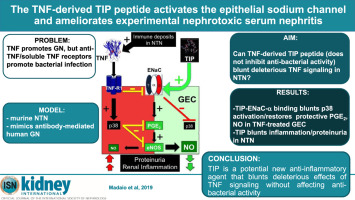Kidney International ( IF 14.8 ) Pub Date : 2019-03-21 , DOI: 10.1016/j.kint.2018.12.022 Michael P Madaio 1 , Istvan Czikora 2 , Nino Kvirkvelia 1 , Malgorzata McMenamin 1 , Qiang Yue 3 , Ting Liu 4 , Haroldo A Toque 5 , Supriya Sridhar 5 , Katherine Covington 6 , Rabei Alaisami 6 , Paul M O'Connor 6 , Robert W Caldwell 7 , Jian-Kang Chen 4 , Matthias Clauss 8 , Michael W Brands 6 , Douglas C Eaton 3 , Maritza J Romero 9 , Rudolf Lucas 10

|
In mice, the initial stage of nephrotoxic serum-induced nephritis (NTN) mimics antibody-mediated human glomerulonephritis. Local immune deposits generate tumor necrosis factor (TNF), which activates pro-inflammatory pathways in glomerular endothelial cells (GECs) and podocytes. Because TNF receptors mediate antibacterial defense, existing anti-TNF therapies can promote infection; however, we have previously demonstrated that different functional domains of TNF may have opposing effects. The TIP peptide mimics the lectin-like domain of TNF, and has been shown to blunt inflammation in acute lung injury without impairing TNF receptor-mediated antibacterial activity. We evaluated the impact of TIP peptide in NTN. Intraperitoneal administration of TIP peptide reduced inflammation, proteinuria, and blood urea nitrogen. The protective effect was blocked by the cyclooxygenase inhibitor indomethacin, indicating involvement of prostaglandins. Targeted glomerular delivery of TIP peptide improved pathology in moderate NTN and reduced mortality in severe NTN, indicating a local protective effect. We show that TIP peptide activates the epithelial sodium channel(ENaC), which is expressed by GEC, upon binding to the channel’s α subunit. In vitro, TNF treatment of GEC activated pro-inflammatory pathways and decreased the generation of prostaglandin E2 and nitric oxide, which promote recovery from NTN. TIP peptide counteracted these effects. Despite the capacity of TIP peptide to activate ENaC, it did not increase mean arterial blood pressure in mice. In the later autologous phase of NTN, TIP peptide blunted the infiltration of Th17 cells. By countering the deleterious effects of TNF through direct actions in GEC, TIP peptide could provide a novel strategy to treat glomerular inflammation.
中文翻译:

TNF 衍生的 TIP 肽激活上皮钠通道并改善实验性肾毒性血清肾炎。
在小鼠中,肾毒性血清诱导的肾炎 (NTN) 的初始阶段与抗体介导的人肾小球肾炎相似。局部免疫沉积物产生肿瘤坏死因子 (TNF),其激活肾小球内皮细胞 (GEC) 和足细胞中的促炎通路。由于 TNF 受体介导抗菌防御,现有的抗 TNF 疗法可以促进感染;然而,我们之前已经证明 TNF 的不同功能域可能具有相反的效果。TIP 肽模拟 TNF 的凝集素样结构域,并且已被证明可以在不损害 TNF 受体介导的抗菌活性的情况下减弱急性肺损伤中的炎症。我们评估了 TIP 肽在 NTN 中的影响。TIP 肽的腹腔内给药减少了炎症、蛋白尿和血尿素氮。保护作用被环氧合酶抑制剂吲哚美辛阻断,表明前列腺素的参与。TIP 肽的靶向肾小球递送改善了中度 NTN 的病理学并降低了重度 NTN 的死亡率,表明具有局部保护作用。我们显示 TIP 肽在与通道的 α 亚基结合后激活由 GEC 表达的上皮钠通道 (ENaC)。在体外,GEC 的 TNF 治疗激活了促炎途径并减少了前列腺素 E2 和一氧化氮的产生,从而促进了 NTN 的恢复。TIP 肽抵消了这些影响。尽管 TIP 肽具有激活 ENaC 的能力,但它并没有增加小鼠的平均动脉血压。在 NTN 自体后期,TIP 肽减弱了 Th17 细胞的浸润。通过直接作用于 GEC 来对抗 TNF 的有害作用,TIP 肽可以提供一种治疗肾小球炎症的新策略。






























 京公网安备 11010802027423号
京公网安备 11010802027423号